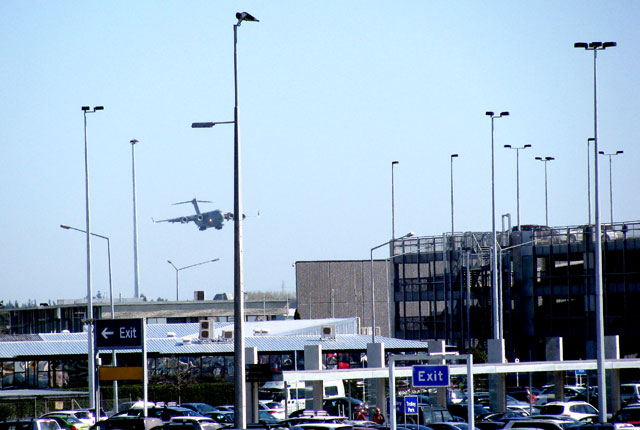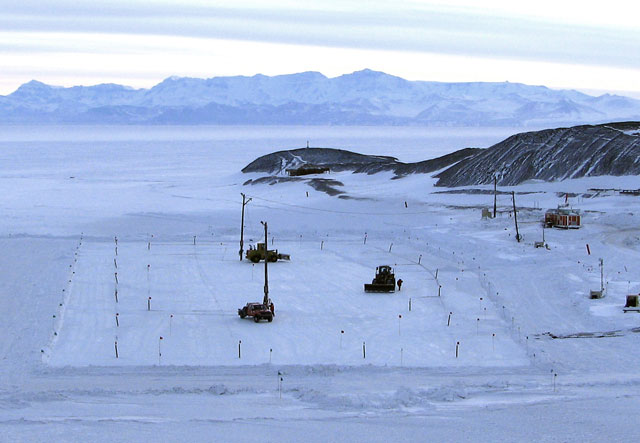'Tis the seasonFirst flights arrive for start of 2011-12 summer in McMurdoPosted October 4, 2011; updated October 7, 2011
The long winter for those hunkered down at McMurdo Station It was the first of 63 scheduled U.S. Air Force C-17 Globemaster IIIs, flown by aircrews from Joint Base Lewis-McChord The season got an official kickoff in Christchurch on Sept. 30 with the city’s annual celebration. This year’s ceremony was particularly poignant, as the city recovers from a series of devastating earthquakes, including a 6.3-magnitude trembler on Feb. 22 that destroyed much of the central business district and killed more than 180 people. [See previous article: Christchurch earthquake.] 
Photo Credit: Ron Rogers
A U.S. Air Force C-17 flies over Christchurch airport as part of 2011-12 opening ceremonies.
Christchurch Mayor Bob Parker said in a press release from the Christchurch City Council that it is an honor that the U.S. and Italian Antarctic programs remain committed to the city despite the widespread damage. As part of this year’s celebrations, a U.S. Air Force C-17 plane did a flyover, performing a “wing rock” as it passed the ChristChurch Cathedral, which was damaged in the Feb. 22 earthquake. In addition to the C-17, which carried 113 passengers, an Australian Antarctic Division The winter isolation had actually been broken back in August during a two-week-long period called winter fly-in (WinFly), when new personnel and cargo arrive to prepare the station for the summer field season. The first flight of WinFly, carrying nearly 120 passengers aboard a C-17, landed on the ice runway at Pegasus airfield shortly after noon on Aug. 20 to coincide with the first sunrise of 2011. About a half-dozen flights eventually arrived with new personnel, scientists and cargo, though nasty weather in McMurdo prolonged WinFly for nearly a week. 
Photo Credit: Jean Varner
An Australian Airbus 319 arrives on Oct. 4 at the sea ice runway near McMurdo Station.
A couple of science groups arrived during WinFly. Among the groups was a team led by Adam Marsh Jody Deming’s WinFly had proceeded as scheduled despite concern that the USAP would not be able to find an icebreaker for the 2011-12 field season. However, at the end of August, the NSF signed a one-year contract, with an option for additional years, with the Russia-based Murmansk Shipping Co. to use the icebreaker Vladimir Ignatyuk. Canadian-built in 1983, Ignatyuk currently provides icebreaking service to other national Antarctic programs including India. [See previous article: Breaking news.] The USAP requires the services of an icebreaker each year to cut a channel through the annual sea ice that fronts McMurdo Station on Ross Island. More than 100 science projects planned for 2011-12 based out of McMurdo and South Pole While many research projects take place in or near the research stations, or aboard the USAP’s two research vessels, several will require field camps far from the few dim lights of civilization that exist on the continent. 
Photo Credit: Marty Reed
Heavy equipment operators work on constructing a new ice pier in Winter Quarters Bay for the 2011-12 summer field season.
Perhaps the most far-flung of the camps will be one near Pine Island Glacier (PIG) in the remotest part of West Antarctica. Support personnel have been moving cargo and supplies via overland traverse to the camp for the last couple of years from another field site called Byrd Surface Camp. [See previous article: Byrd Camp resurfaces.] The so-called PIG camp will be the staging area for two helicopters that will move science equipment, support infrastructure, and scientists to the highly crevassed PIG Ice Shelf about 45 nautical miles away. The scientists will drill through the ice 600-meter-thick ice shelf to send instruments into the ice shelf cavity below to monitor the ocean-ice interface. [See previous article: Cracking the case.] The project team hopes to better understand the processes under way that are melting the ice shelf from below and causing the glacier that feeds into it to flow faster. This region of Antarctica is expected to be one of the main contributors to sea-level rise in the coming century. The 49 people wintering over at the South Pole Station will have to wait about two more weeks before the summer crew begins to arrive there. The first Basler, a retrofitted Douglas DC3, is scheduled to fly to the Pole on Oct. 17, with two more such flights planned over the following week. The first LC-130 ski-equipped plane, flown by the New York Air National Guard The South Pole Operations Traverse, or SPoT, plans to attempt to make two trips between McMurdo and South Pole this summer to supply the world’s southernmost research outpost with additional fuel and cargo. Each traverse, a train of large tractors pulling sleds of fuel bladders and other supplies, offsets about 30 LC-130 flights. The Antarctic 2011-12 summer field season runs through February, with the last plane scheduled to leave the continent on Feb. 24.
|



For USAP Participants |
For The Public |
For Researchers and EducatorsContact UsU.S. National Science FoundationOffice of Polar Programs Geosciences Directorate 2415 Eisenhower Avenue, Suite W7100 Alexandria, VA 22314 Sign up for the NSF Office of Polar Programs newsletter and events. Feedback Form |


